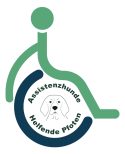The way to the assistance dog
Many questions reach us about how the process is from the request to the moving in of the dog or even to its retirement. Therefore, we have decided to outline the process here, individual deviations are of course possible!
Step 1: Application
You contact us by e-mail or telephone and receive from us, in addition to initial information, our application form. Please return this to us, together with proof of disability.
Step 2: get to know each other personally
On the basis of the application, we decide whether we can meet your needs or wishes and whether cooperation seems possible in principle. If the decision is positive, you will be invited to a non-binding meeting at the club’s headquarters in 51491 Overath.
3. decision for cooperation / support
After getting to know each other, you decide – as we do – for or against cooperation. If you decide not to cooperate, your documents will be archived in accordance with data protection regulations.
In the case of a joint decision for cooperation, three different variants can be considered:
- A potential (assistance) dog is already in basic training with Helping Paws: In this case, a further meeting between you, us and the dog, will clarify whether the sympathy is present on all sides and the dog fits you and your needs. At the earliest age of 18 months, the future assistance dog can pass a major health check and a so-called quality test. If both are positive, the induction can start.
- We currently do not have a suitable dog in basic training: in this case we look for a potentially suitable dog (puppy or young dog), acquire it, train the basics with it, prepare it for the health check and the so-called quality test. If both go positively, the induction can start with you.
- You already live with a dog that is to complete the training together with you: In an age-appropriate aptitude test, we look at whether your dog could enjoy the job as an assistance dog. Depending on the age of the dog, after a health check, the joint training starts (if your dog is older than 15 months) or you first complete the puppy and young dog training. This can be done with us or in a family dog school on site with you and with our accompaniment.
Under current law, assistance dog training includes only specialized training. This may be started at the earliest at the beginning of the 16th month of life of the dog and after a positive health check by a veterinarian.
However, we recommend that you let the young dog enjoy his youth and not start special training until he is 18 months of age or older.
4. familiarization with external training (variants a) and b))
After health check and quality test, the training starts with you. The form of familiarization depends on the local distance between you and the accompanying trainer, your experience in dealing with dogs and the actual training needs. Basically, 5 training days at the organization’s headquarters and approximately 20 days at your place of residence are calculated. The training is spread over several appointments in a period of 6 weeks to approx. 6 months, depending on requirements and distance. Of course, we take into account the legally required 60 hours of joint training.
4b) The joint training in the accompanied self-education.
If your dog is old enough (at least 15 months), has passed the health check and our aptitude test, we start together with the special training. This includes a minimum of 60 time hours in individual & group training as well as theory.
If your dog is younger than 15 months, we will gladly accompany you through the puppy and young dog period and gently prepare you for life together as an assistance dog team and later training.
5. team test
The familiarization process ends with a team examination. This takes place at your place of residence or at the organization’s headquarters.
6. aftercare
After successful team testing, there will be another training MONTHLY in the first six months after the team testing. During the following six months, training is held EVERY 2 MONTHS. After one year, this interval can be extended to 3 – 4 months. A veterinary health check must be performed annually, a form will be provided.
7. pension of the dog
At some point, there comes a time when the assistance dog becomes too old for his “job”.
Legislation provides that assistance dogs retire on their tenth birthday. Exceptions may be made if the veterinarian approves. But at the age of 12 at the latest, an assistance dog stops working and is allowed to take his well-deserved retirement.
Because Helping Paws stays in contact with you throughout the dog’s lifetime, in most cases we can work with you early on to consider what the dog’s future might look like. Some dogs stay with their assistance family as retirees, some come back to us. When exactly a dog is retired is decided in close cooperation between the trainers, the management and the family veterinarian.

